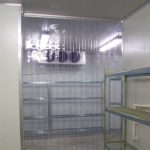What Are The Basic Components Of A Freezer?
- 21 July 2015
A handful of mechanisms can be quoted by historians as major life-changers, the devices that granted us dominion over a higher quality of life. A machine that can turn water into ice and change a swelteringly hot room into an icy chamber definitely makes it onto this list. A freezer achieves this modern magic by taking advantage of the laws of thermodynamics. On looking behind the metaphorical curtains, the magic is really more of a scientific principle, one known as heat transferal through the compression and expansion of chemical gases. The components in this cooling and heating cycle harness some handy laws of physics, but let’s leapfrog intangible concepts and gain an understanding of the components that realize this theory.
1. An Insulated Cooling Space
A walk-in freezer uses insulating panels with a superior R-factor (thermal efficiency rating). A durable metal construction and the installation of state-of-the-art insulating materials count for everything in this design.
2. The Vaporized Refrigerant
Eco-friendly and highly efficient, HFCs, HCFCs and CFCs are the standard compounds used within freezer, though these highly regulated chemicals are currently being phased out due to their ozone layer depletion properties. Mainly speaking, potential environmental impact should be balanced by superior physical properties.
The Mechanics of the System
The working parts of a freezer include the following basic components:
- A condenser coil
- An evaporator coil
- One or more electric fans
- An expansion valve
- A compressor vessel
The body of parts, when assembled, forms a circuit. The refrigerant passes into the compressor. The sealed vessel converts the low-pressure gas into a pressurized liquid, a change of state that produces heat behind the freezer. The vessel has to be rated to contain the pressure and to then pump the hot liquid to the next stage. The circuit concludes with the condenser coils and the evaporator coils, stages that harness those laws of thermodynamics we mentioned earlier. The evaporator coils receive the refrigerant as it rises in pressure and changes state once more, moving from liquid back to gas. The working fluid, refrigerant, acts as the transferal medium, absorbing and rejecting heat, with the expansion valve regulating the thermodynamic state of the refrigerant. An electric fan then blows the resulting mist of freezing-cold air. All of this freezing air is produced as a direct consequence of heat absorption as caused by the evaporation and pressure drop phase when the refrigerant pushes through the evaporative coil on its return voyage back to the compressor.
Compressor and fluid, condenser coil and evaporator coils, all are crucial parts in a freezer. Notably, when this arrangement is scaled up to handle walk-in freezer layouts, the system assumes an even more complex profile. Additional fans can enter the configuration to funnel away heat generated by the compressor, though passive cooling systems are typically adequate for this purpose.
Mark Connelly
C&M Coolroom Services
E-mail : markconnelly@cmcoolrooms.com.au
Mobile: 0412 536 315


